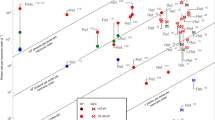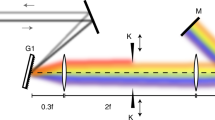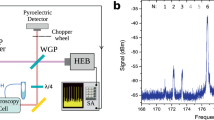Abstract
High-precision measurements with molecules may refine our knowledge of various fields of physics, from atmospheric and interstellar physics to the standard model or physics beyond it. Most of them can be cast as absorption frequency measurements, particularly in the mid-infrared ‘molecular fingerprint’ region, creating the need for narrow-linewidth lasers of well-controlled frequency. Quantum cascade lasers provide a wide spectral coverage anywhere in the mid-infrared, but show substantial free-running frequency fluctuations. Here, we demonstrate that the excellent stability and accuracy of an ultra-stable near-infrared laser, transferred from a metrological institute through a fibre link, can be copied to a quantum cascade laser using an optical frequency comb. The obtained relative stability and accuracy of 2 × 10−15 and 10−14 exceed those demonstrated so far with quantum cascade lasers by almost two orders of magnitude. This set-up enables us to measure molecular absorption frequencies with state-of-the-art uncertainties, confirming its potential for ultra-high-precision spectroscopy.
This is a preview of subscription content, access via your institution
Access options
Subscribe to this journal
Receive 12 print issues and online access
$209.00 per year
only $17.42 per issue
Buy this article
- Purchase on Springer Link
- Instant access to full article PDF
Prices may be subject to local taxes which are calculated during checkout





Similar content being viewed by others
References
Carr, L. D., DeMille, D., Krems, R. V. & Ye, J. Cold and ultracold molecules: science, technology and applications. New J. Phys. 11, 055049 (2009).
Barry, J. F., McCarron, D. J., Norrgard, E. B., Steinecker, M. H. & DeMille, D. Magneto-optical trapping of a diatomic molecule. Nature 512, 286–289 (2014).
Tokunaga, S. K. et al. Probing weak force-induced parity violation by high-resolution mid-infrared molecular spectroscopy. Mol. Phys. 111, 2363–2373 (2013).
Baron, J. et al. Order of magnitude smaller limit on the electric dipole moment of the electron. Science 343, 269–272 (2014).
De Angelis, M., Gagliardi, G., Gianfrani, L. & Tino, G. M. Test of the symmetrization postulate for spin-0 particles. Phys. Rev. Lett. 76, 2840–2843 (1996).
Koelemeij, J. C. J., Roth, B., Wicht, A., Ernsting, I. & Schiller, S. Vibrational spectroscopy of HD+ with 2-ppb accuracy. Phys. Rev. Lett. 98, 173002 (2007).
Daussy, C. et al. First direct determination of the Boltzmann constant by an optical method: towards a new definition of the kelvin. Phys. Rev. Lett. 98, 250801 (2007).
Moretti, L. et al. Determination of the Boltzmann constant by means of precision measurements of H2O line shapes at 1.39 µm. Phys. Rev. Lett. 111, 060803 (2013).
Shelkovnikov, A., Butcher, R. J., Chardonnet, C. & Amy-Klein, A. Stability of the proton-to-electron mass ratio. Phys. Rev. Lett. 100, 150801 (2008).
Hudson, E. R., Lewandowski, H. J., Sawyer, B. C. & Ye, J. Cold molecule spectroscopy for constraining the evolution of the fine structure constant. Phys. Rev. Lett. 96, 143004 (2006).
Jansen, P., Bethlem, H. L. & Ubachs, W. Perspective: tipping the scales: search for drifting constants from molecular spectra. J. Chem. Phys. 140, 010901 (2014).
Hugi, A., Villares, G., Blaser, S., Liu, H. C. & Faist, J. Mid-infrared frequency comb based on a quantum cascade laser. Nature 492, 229–233 (2012).
Schliesser, A., Picqué, N. & Hänsch, T. W. Mid-infrared frequency combs. Nature Photon. 6, 440–449 (2012).
Faist, J. et al. Quantum cascade laser. Science 264, 553–556 (1994).
Yao, Y., Hoffman, A. J. & Gmachl, C. F. Mid-infrared quantum cascade lasers. Nature Photon. 6, 432–439 (2012).
Bielsa, F. et al. HCOOH high resolution spectroscopy in the 9.18 µm region. J. Mol. Spec. 247, 41–46 (2008).
Bartalini, S. et al. Frequency-comb-referenced quantum-cascade laser at 4.4 μm. Opt. Lett. 32, 988–990 (2007).
Bressel, U., Ernsting, I. & Schiller, S. 5 µm laser source for frequency metrology based on difference frequency generation. Opt. Lett. 37, 918 (2012).
Borri, S. et al. Direct link of a mid-infrared QCL to a frequency comb by optical injection. Opt. Lett. 37, 1011–1013 (2012).
Cappelli, F. et al. Subkilohertz linewidth room-temperature mid-infrared quantum cascade laser using a molecular sub-Doppler reference. Opt. Lett. 37, 4811–4813 (2012).
Mills, A. A. et al. Coherent phase lock of a 9 µm quantum cascade laser to a 2 µm thulium optical frequency comb. Opt. Lett. 37, 4083–4085 (2012).
Galli, I. et al. Comb-assisted subkilohertz linewidth quantum cascade laser for high-precision mid-infrared spectroscopy. Appl. Phys. Lett. 102, 121117 (2013).
Hansen, M. G. et al. Robust, frequency-stable and accurate mid-IR laser spectrometer based on frequency comb metrology of quantum cascade lasers up-converted in orientation-patterned GaAs. Opt. Express 21, 27043–27056 (2013).
Sow, P. L. T. et al. A widely tunable 10-μm quantum cascade laser phase-locked to a state-of-the-art mid-infrared reference for precision molecular spectroscopy. Appl. Phys. Lett. 104, 264101 (2014).
Tombez, L., Schilt, S., Hofstetter, D. & Südmeyer, T. Active linewidth-narrowing of a mid-infrared quantum cascade laser without optical reference. Opt. Lett. 38, 5079–5082 (2013).
Acef, O. Metrological properties of CO2/OsO4 optical frequency standard. Opt. Commun. 134, 479–486 (1997).
Bernard, V. et al. Spectral purity and long-term stability of CO2 lasers at the hertz level. IEEE J. Quantum Electron. QE-31, 1913–1918 (1995).
Fasci, E. et al. Narrow-linewidth quantum cascade laser at 8.6 µm. Opt. Lett. 39, 4946–4949 (2014).
Hagemann, C. et al. Ultrastable laser with average fractional frequency drift rate below 5 × 10−19/s. Opt. Lett. 39, 5102–5105 (2014).
Guéna, J. et al. Progress in atomic fountains at LNE-SYRTE. IEEE Trans. Ultrason. Ferroelec. Freq. Control 59, 391–410 (2012).
Amy-Klein, A. et al. Absolute frequency measurement of a SF6 two-photon line by use of a femtosecond optical comb and sum-frequency generation. Opt. Lett. 30, 3320–3322 (2005).
Chanteau, B. et al. Mid-infrared laser phase-locking to a remote near-infrared frequency reference for high-precision molecular spectroscopy. New J. Phys. 15, 073003 (2013).
Vainio, M., Merimaa, M. & Halonen, L. Frequency-comb-referenced molecular spectroscopy in the mid-infrared region. Opt. Lett. 36, 4122–4124 (2011).
Jiang, H. et al. Long-distance frequency transfer over an urban fiber link using optical phase stabilization. J. Opt. Soc. Am. B 25, 2029–2035 (2008).
Predehl, K. et al. A 920-kilometer optical fiber link for frequency metrology at the 19th decimal place. Science 336, 441–444 (2012).
Bernard, V. et al. CO2 laser stabilization to 0.1-Hz level using external electrooptic modulation. IEEE J. Quantum Electron. 33, 1282–1287 (1997).
Ducos, F., Hadjar, Y., Rovera, G. D., Zondy, J. J. & Acef, O. Progress toward absolute frequency measurements of the 127I2-stabilized Nd:YAG laser at 563.2 THz/532 nm. IEEE Trans. Instrum. Meas. 50, 539–542 (2001).
Elliott, D. S., Roy, R. & Smith, S. J. Extracavity laser band-shape and bandwidth modification. Phys. Rev. A 26, 12–18 (1982).
Acef, O., Michaud, F. & Rovera, G. D. Accurate determination of OsO4 absolute frequency grid at 28/29 THz. IEEE Trans. Instrum. Meas. 48, 567–570 (1999).
Chardonnet, C. & Borde, C. J. Hyperfine interactions in the ν3 band of osmium tetroxide: accurate determination of the spin-rotation constant by crossover resonance spectroscopy. J. Mol. Spectrosc. 167, 71–98 (1994).
Chardonnet, C. Spectroscopie de saturation de hautes précision et sensibilité en champ laser fort. Applications aux molécules OsO 4 , SF 6 et CO 2 et à la métrologie des fréquences. Thèse de doctorat d’état, Université Paris 13 (1989).
Daussy, C. et al. Long-distance frequency dissemination with a resolution of 10−17. Phys. Rev. Lett. 94, 203904 (2005).
Salumbides, E. J. et al. Bounds on fifth forces from precision measurements on molecules. Phys. Rev. D 87, 112008 (2013).
Karr, J. P. et al. High-accuracy calculations in the H2+ molecular ion: towards a measurement of mp/me Can. J. Phys. 85, 497–507 (2007).
Guinet, M., Mondelain, D., Janssen, C. & Camy-Peyret, C. Laser spectroscopic study of ozone in the 100←000 band for the SWIFT instrument. J. Quant. Spectr. Rad. Transfer 111, 961–972 (2010).
Schneider, M. & Hase, F. Improving spectroscopic line parameters by means of atmospheric spectra: theory and example for water vapor and solar absorption spectra. J. Quant. Spectr. Rad. Transfer 110, 1825–1839 (2009).
Telle, H. R., Lipphardt, B. & Stenger, J. Kerr-lens, mode-locked lasers as transfer oscillators for optical frequency measurements. Appl. Phys. B 74, 1–6 (2002).
Nicolodi, D. et al. Spectral purity transfer between optical wavelengths at the 10−18 level. Nature Photon. 8, 219–223 (2014).
Zhang, W. et al. Characterizing a fiber-based frequency comb with electro-optic modulator. IEEE Trans. Ultrason. Ferroelec. Freq. Control 59, 432–438 (2012).
Rohart, F. et al. Absorption line shape recovery beyond the detection bandwidth limit: application to the precision spectroscopic measurement of the Boltzmann constant. Phys. Rev. A 90, 042506 (2014).
Acknowledgements
The authors thank P.-E. Pottie, G. Santarelli, R. Le Targat and W.-K. Lee for discussions as well as helping with the ultra-stable NIR lasers or the active compensated optical link. The authors also thank S. Tokunaga for reading the manuscript and for helping with linewidth calculations. The authors acknowledge financial support from the Centre National de la Recherche Scientifique, Agence Nationale de la Recherche (ANR BLANC LIOM 2011 BS04 009 01, ANR QUIGARDE 2012 ANR-12-ASTR-0028-03, ANR NCPCHEM 2010 BLAN 724 3, Labex First-TF ANR 10 LABX 48 01), Action Spécifique Gravitation, Références, Astronomie, Métrologie (GRAM) and Université Paris 13.
Author information
Authors and Affiliations
Contributions
B.A., B.C., O.L., Y.L.C. and A.A.K. conceived and designed the experiment. B.A., B.C., D.N., B.D. and A.A.K. performed the experiment. B.A., O.L., D.N., M.A., C.D., B.D., Y.L.C. and A.A.K. analysed the data. B.A., M.A., B.D., Y.L.C. and A.A.K. contributed materials/analysis tools. All authors discussed the results. B.A., O.L., D.N., M.A., C.C., C.D., B.D., Y.L.C. and A.A.K. wrote the paper.
Corresponding authors
Ethics declarations
Competing interests
The authors declare no competing financial interests.
Rights and permissions
About this article
Cite this article
Argence, B., Chanteau, B., Lopez, O. et al. Quantum cascade laser frequency stabilization at the sub-Hz level. Nature Photon 9, 456–460 (2015). https://doi.org/10.1038/nphoton.2015.93
Received:
Accepted:
Published:
Issue Date:
DOI: https://doi.org/10.1038/nphoton.2015.93
This article is cited by
-
Frequency-stabilized narrow-linewidth double-mode quantum cascade laser
Optical and Quantum Electronics (2022)
-
Comparing ultrastable lasers at 7 × 10−17 fractional frequency instability through a 2220 km optical fibre network
Nature Communications (2022)
-
Kerr combs bring purity to millimetre waves
Nature Photonics (2021)
-
Proton–electron mass ratio by high-resolution optical spectroscopy of ion ensembles in the resolved-carrier regime
Nature Physics (2021)
-
Femtosecond pulses from a mid-infrared quantum cascade laser
Nature Photonics (2021)



